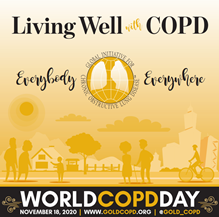World COPD Day – November 18th
While there is no cure for COPD, there are ways to help current patients live well and actions that can prevent new cases.

The 19th annual World COPD Day takes place on November 18, 2020 and has the goal of raising awareness and presenting new knowledge about this disease. This year’s theme for World COPD Day is “Living Well With COPD – Everybody, Everywhere.” While there is no cure for COPD, there are ways to help current patients live well and actions that can prevent new cases. COPD – which stands for chronic obstructive pulmonary disease – includes the chronic lung conditions of chronic bronchitis and emphysema, which are characterized by airflow obstruction and breathing-related problems. COPD is a major cause of illness, with an estimated 300 million cases worldwide, and is the 3rd leading cause of death globally.
The leading preventable cause of COPD is cigarette smoking, and prevention efforts have focused on limiting this exposure. Controlling exposure to other harmful agents can also help reduce the number of COPD cases. Occupational exposures are important causes of COPD, contributing to an estimated 14% of all cases and 31% of cases among never smokers (Blanc 2019).
Workplace agents associated with COPD include:
- mineral dusts (coal mine dust, silica, asbestos),
- organic dusts (cotton, wood, grains),
- metal/welding fumes (cadmium),
- diesel/engine exhaust fumes,
- asphalt/tar fumes or vapors in road and roofing operations,
- smoke from fires, and
- other chemical gases or vapors.
Various actions can minimize exposures to these work-related COPD agents and prevent the onset of new cases and worsening of existing cases.
NIOSH supports awareness and prevention of COPD
CDC’s National Institute for Occupational Safety and Health (NIOSH) conducts research and outreach to support awareness and prevention of COPD. Through the National Occupational Research Agenda (NORA), NIOSH developed the online video series Faces of Work-related COPD to communicate directly with workers about how occupational exposures can impact their respiratory health. The four short videos include interviews with work-related COPD patients who discuss work exposures, their quality of life with the disease, and ways to minimize the risks of getting the disease.
NIOSH also developed the Spirometry Longitudinal Data Analysis (SPIROLA) Software that can be downloaded free of charge. This software assists health care providers in tracking and interpreting results from breathing tests that were conducted on multiple occasions over time. The insights provided by SPIROLA can help identify COPD in the earlier stages of disease when limiting further harmful exposures might prevent progression to severe disease.
The NIOSH Total Worker Health® approach can contribute to preventing COPD in workers by integrating protection from work-related health hazards with promotion of injury and illness-prevention efforts. This comprehensive approach to improving the health of workers goes beyond exposures at work to also include tobacco smoke. NIOSH recommends that employers implement smoke-free workplace policies and provide support for employees who want to stop using tobacco products (Castellan 2015).
References
Blanc PD, Annesi-Maesano I, Balmes JR, et al. The occupational burden of nonmalignant respiratory diseases: An Official American Thoracic Society and European Respiratory Society Statement. Am J Respir Crit Care Med;199:1312–1334.
Castellan RM, Chosewood LC, Trout D, Wagner GR, Weissman DN, Caruso CC, Mazurek J, McCrone SH. Promoting health and preventing disease and injury through workplace tobacco policies. 2015 DHHS (NIOSH) Publication Number 2015-113.
